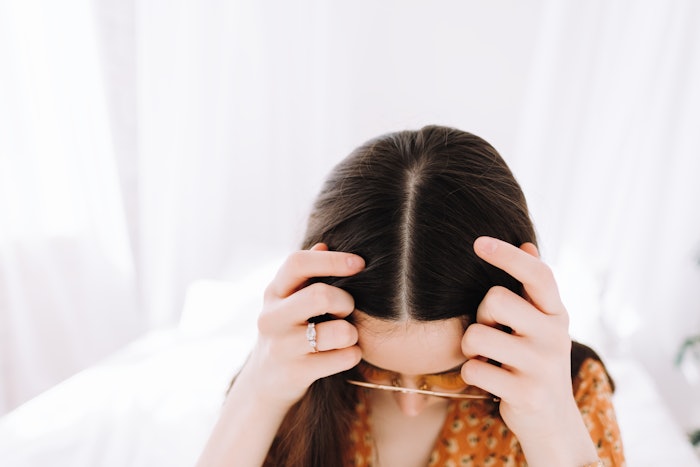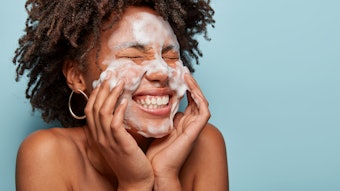
The global hair and scalp care market is expected to generate a revenue of about $94 billion in 2024, with an anticipated CAGR of 2.8% in the next four years.1 Anti-dandruff, hair loss, dry and itchy scalp, dry and dull hair, and white/gray hair product categories dominate,2 while products targeting scalp comfort and care have emerged as their own sub-category thanks to a few combined factors.
Log in to view the full article
The global hair and scalp care market is expected to generate a revenue of about $94 billion in 2024, with an anticipated CAGR of 2.8% in the next four years.1 Anti-dandruff, hair loss, dry and itchy scalp, dry and dull hair, and white/gray hair product categories dominate,2 while products targeting scalp comfort and care have emerged as their own sub-category thanks to a few combined factors.
On one hand, consumers have become more conscious that a healthy scalp is the foundation of beautiful hair, and that environmental stressors can contribute to scalp issues.3, 4 On the other hand, brands are constantly innovating and adding to their product portfolios. Samuel Gourion-Arsiquaud, Ph.D., of the TRI Princeton research center, reports that skin care brands extending into scalp care and expanding on current claims, plus booming interest in hair growth products are some factors fueling this category’s growth.5 Reflecting this, the research center, known historically for its focus on hair material science, has in the last decade expanded beyond testing hair tresses to develop methodologies to study the skin, nails and scalp.
Although the scalp is an extension of skin, its features are quite different. It is covered with a high density of hair growing from follicles that are connected to sebaceous glands.6 This creates a lipid-rich hydrophobic environment that harbors a variety of microorganisms that are different from other body parts.7 As a result, the scalp microbiome is richer in fungus than bacteria, with Malassezia being the dominant species, per Oliver Worsley, Ph.D., at Sequential, a microbiome research and testing facility. As a comparison, the facial skin, though near the scalp, is dominant in bacteria species, justifying the need to develop targeted products for different body parts and the conditions affecting them.7
This article explores test methods applied today to create scalp care products to address scalp conditions such as inflammation, redness, dandruff (D) and seborrheic dermatitis (SD). D and SD, in particular, are perhaps the most widespread and their treatments fall into the realm of cosmetics and OTC drugs. Schwartz, et al., describe D/SD as a singular condition manifesting in varying severities.8 In the authors’ review, D/SD is broken down into four sequential phases: interaction between Malassezia species and the epidermis; initiation and propagation of inflammation; disruption in epidermal proliferation and differentiation; and weakening of the skin barrier function.
These phases correspond to symptoms and signs such as erythema, itch, flaking and sensations of dryness and tightness.8 In a simplified manner, scalp health that is disturbed can be considered “Malassezia breaking down scalp sebum by their lipase enzymes,” according to Worsley. “[A]nd the unsaturated fatty acids generated are thought to lead to dermatitis,” he added.
To develop scalp care products that address such symptoms and validate their safety and efficacy, various tools are used. It is worth noting many experts agree that biophysical measurement tools to assess skin hydration,a sebumb and TEWL do not lend themselves to track the same properties directly on the hair-dense scalp.6, 9 As such, the industry has devised and adopted various strategies to assess products targeting scalp comfort and care – a sampling of which is the focus of this article.
Preclinical Testing
Consumer/subjective assessment: Starting with a fundamental approach, like other product categories, scalp care can benefit from consumer studies to determine how a formula is perceived. This can generate valuable insights for product efficacy and set the direction for developing product claims.
For example, a study reported by Xie, et al., gathered consumer feedback from 100 total women in their 20s and 30s living in Shanghai and Bejing about three scalp shampoo products – two silicone-free formulas and one silicone oil-containing formula.10 While no obvious differences were apparent in preferences among different ages, there were among different regions. Beijing consumers were satisfied with the sensory efficacy of the three products while Shanghai consumers were less satisfied. The authors speculated that Shanghai consumers had a higher expectation for scalp care.10
In addition, the products containing silicone oil showed higher usage satisfaction. Notably, although the tested products had scalp care functions, the consumers were more concerned about the effects of the products on hair health.10
In vitro: In an ideal world, laboratory tests would correlate with real-world behavior but designing in vitro tests that can predict clinical conditions and behaviors is difficult. Stages of D/SD vary with each individual, so effectively controlling scalp moisturization or sebum levels requires ensuring products do not impact existing levels in a negative way. Another factor is the scalp microbiome, which is a dynamic ecosystem of multiple microorganisms – and putting faith in an in vitro test that consists of just three to five species is unlikely to provide the full picture, according to Worsley.7
In one successful example, Tsai, et al., first applied an in vitro test to measure the effects of a heat-treated Lacticaseibacillus paracasei GMNL-653, an organism that belongs in the family of lactic acid bacteria, on dandruff and oil secretion on the scalp. In this test, GMNL-653 was shown to co-aggregate with Malassezia furfur, a common scalp fungus, and was shown to upregulate human cell lines HS68 and HaCaT.6
Based on the success of this in vitro test, a heat-killed GMNL-653-containing shampoo was developed and found to successfully decrease dandruff and oil secretion while also increasing hair growth in 22 clinical subjects after five months of product use. These researchers were therefore able to show efficacy of their treatment in a clinical study after having observed a potential benefit in their in vitro studies.
Cosmetic ingredient suppliers are devising new strategies as well. Lubrizol Life Science Beauty released tests for Fensebiome peptide (INCI: Water (Aqua) (and) Acetyl Heptapeptide-4 (and) Caprylyl Glycol) wherein data showed a reduction of Kallicrein-5 and PAR-2 activation, helping to relieve inflammatory and itching skin and scalp conditions as also confirmed by a consumer study.11
Ex vivo: Another ingredient company, Symrise, created an ex vivo model with sebaceous gland cultures to screen products for their sebum reduction capacity in the hair and scalp. According to the company, results from this technique can be applied to in vivo applications.12
In vivo: In vivo testing could also be used to evaluate the merit of a scalp care product before investing in a full clinical study, although examples are somewhat limited in the literature of true in vivo instrumental measurements for D/SD type conditions. However, one techniquec has been developed using infrared spectroscopy in conjunction with a specialized probe that penetrates between hair fibers to determine both the moisture and sebum levels within the first two micrometers of the stratum corneum and right above the scalp surface.
This can be described as a semi-quantitative method to track sebum and moisture levels and product buildup over time.6 Depending on the outcome of these evaluations, if the merit of a product is identified, a larger (e.g., n = 120) panelist clinical study can be designed.
In other work, Jo, et al.,13 used quantitative real-time PCR to measure the relative expressions of superoxide dismutase 2 (SOD2), forkhead box O1 (FOXO1), actinin alpha 1 (ACTN1), collagen type XVII alpha 1 chain (COL17A1) and integrin subunit beta 4 (ITGB4) to determine the potential of acetyl hexapeptide-8 (AH) ampoules for anti-aging scalp treatments. Changes in SOD2 and FOXO1 mRNA expression indicated potential antioxidant activity, that could be applicable for treatment of D/SD symptoms as well.13
In addition, devices based on traditional approaches have been adapted to measure scalp characteristics. One based on an approach to measure the lipid content in tear films can measure sebum on the scalp and between hairs using a special adapter, per the manufacturerd. Another uses a specialized UVA light video camera with high resolution to study the scalp and hair surface directlye. In this case, Surface Evaluation of the Living Skin (SELS) parameters were developed specifically for this camera to show the structure of skin and images of hair and scalp.14
Clinical Testing
When designing clinical tests, it is, of course, best practice to maximize the opportunity to collect as many data points as possible, including instrumental and expert assessments. As such, clinicals to determine the safety, efficacy and proper claims for scalp care products will likely include a combination of the following tests.
Instrumental: As noted, tools commonly used in determining the efficacy of skin care products cannot be used with ease in scalp care clinicals. According to one industry expert, however, it is possible to use the customary tools on areas of skin adjacent to the scalp to infer the moisturization and sebum control efficacy of scalp care products.9
Image analysis: Piérard-Franchimont, et al., report on a visual method using adhesive-coated clear discs to document scalp flakiness that could be used in conjunction with a clinical study. Here, the authors were able to rate the severity of the scalp condition and efficacy of scalp-care compounds by sampling the flakes collected from 40 volunteers. They then used image analysis to quantify the specular light reflectance of the flakes, which highlighted the flakiness with high contrast against a black background, allowing for objective measurements.15
Park, et al., described another approach to evaluate the scalp soothing efficacy of test products based on a deviceg that measures skin color. Here, a tool that uses white LED lamps corresponding to daylight are arranged in a circle inside a measurement chamber. When the device is brought into contact with the skin surface for measurement, the LED is illuminated at a 45-degree angle to the skin to minimize skin gloss, and the RGB color sensor detects the light reflected from the skin. Per the manufacturer, based on the measured RGB color, the CIE L*a*b* value, L*c*h* color, ITA degree erythema index and melanin index value are automatically calculated and displayed.16
In other work, Ha, et al.,17 compared three artificial intelligence (AI) health care models to aid in the early detection of scalp hair disorders. The deep learning platforms, including ResNet-152, EfficientNet-B6 and ViT-B/16, examined images to assess the severity levels of six common conditions such as dryness, oiliness, erythema, folliculitis dandruff and hair loss to establish suitable scalp image classification models. Per the authors, the ViT-B/16 model exhibited the best classification performance with an average accuracy of 78.31%. Accordingly, this proposed platform facilitates objective monitoring states of the scalp and early diagnosis of hairy scalp problems, which could be used to inform treatment options and formulation development.17
Clinical photography: As the saying goes, a picture is worth a thousand words, and clinical photography is perhaps the most highly valuable approach when conducting scalp clinicals (see Image 1). In addition to using high quality photography and image analysis for rating clinical efficacy, photographs provide great visuals that can be marketed on product websites to showcase the rigor that has been employed when evaluating the product.
Expert grading: As in testing skin care products, expert grading is one of the cornerstones in clinical testing for scalp products. Roughness, flaking, irritation and redness are among the routine scalp health attributes evaluated by experts during a scalp clinical, as Jane Tervooren and Brian Ecclefield, co-founders at Validated Claims Support, explained.9,18
Expert grading was employed by Fithian, et al., to showcase the efficacy of a topical treatment primarily consisting of probiotic extracts (Lactobacillus spp.), honey, turmeric and vitamin B12 in children ages 1–17 with dry scalp and dandruff symptoms, as determined by a trained research physician. Forty-two children with dry scalp participated in the study and use of the topical treatment for two weeks was associated with reduced symptoms of itchiness, dryness, irritation and flakiness, as indicated by both expert grading and parent-fielded subjective surveys.19
Microbiome testing: Strong evidence has been found correlating D/SD with microorganisms colonizing the scalp – and although skin microbiome testing is in its infancy, having access to it is not as futuristic as it sounds.7, 20, 21 In fact, clinicals today incorporate swabbing of the scalp before and after product use to track microbiome changes.18,21
For maximum insight, expertly swabbed samples at a clinical testing facility can be submitted to a partnering laboratory specializing in the microbiome to the determine the species and even strain levels.7 In one example, such a company created a database after collaborating with more than 60 companies correlating microbiome and ingredient interactions to help brands navigate new formulation avenues for microbiome-focused options. Thanks to ever-increasing data points, the future of testing lies with AI, according to Worsley, whose testing facility uses AI to find connections between formulas and microbiome maintenance.7
Future of Testing
L’Oréal is taking a step beyond the clinic by putting scalp care directly in the hands of hair stylists.22 Its Kérastase brand introduced K-Scan, a camera the provides stylists and their clients detailed knowledge about hair and scalp conditions using microscopic images combined with AI-powered analysis. According to the company, the device is powered by three illumination modes (UV, white and cross-polarized) and is AI trained by more than 12,000 images to allow stylists to see directly into the scalp, while its companion tablet app offers expert analysis of the scan right in the salon. It would be interesting to follow the evolution of such instrumentation being applied in clinical studies.21
There is a definite increase in the amount of study requests for hair and scalp care, according to Ecclefield:9 “[The] hair care category is in need of scientifically proven products and is being recognized as distinct from skin care for the first time.”
In addition, MoCRA requires products to be tested in a manner relevant to their intended use, which necessitates the development of specific protocols. Direct to consumer brands also need to gain the confidence of their consumers not just by making claims, but also by validating them. Several lawsuits in this category related to hair loss or benzene content have elevated the importance of claims support. Hence the need for carefully designed and executed tests – specifically clinical tests, aka the golden standard to showcase safety and efficacy, are here to stay.9
Whatever their needs, today’s consumers are discerning and demand products that are not only cosmetically appealing but do the job. In a crowded marketplace, brands basing their innovation on science and backing their marketing claims with testing are best positioned for success. As such, the future of product innovation in scalp care is exciting.
(footnotes)
a Corneomter and
b Sebumeter, Courage & Khazaka
c Science and Biological Substrates Lab, TRI Princeton
d Meibometer MB 560 and
e Visioscan VC 20plus, Courage & Khazaka
(end footnotes)
References
1. Statista (2024, March). Hair Care — Worldwide. Statista. Available at https://docs.google.com/document/d/1eQYe3YKalmU518DTcihkDU9hrQ64WQxUjW7XcUQi2V8/edit
2. Grand View Research (accessed 2024, March 28). Hair And Scalp Care Market Size, Share & Trends Analysis Report By Product (Anti-dandruff, Hair Loss, Dry & Itchy Scalp, Dry & Dull Hair, White & Grey Hair), By Distribution Channel, By Region, And Segment Forecasts, 2021 – 2028. Grand View Research. Available at https://www.grandviewresearch.com/industry-analysis/hair-care-market#
3. Trueb R.M., Henry J.P, Davis, M.G., Schwartz, J.R. (2018). Scalp Condition Impacts Hair Growth and Retention via Oxidative Stress, Int. J. Trichology, 10(6): 262–270.
4. Dall’Oglio, F., Nasca,M.R.,Gerbino,C.Micali, G. (2022). An Overview of the Diagnosis and Management of Seborrheic Dermatitis, Clin Cosmet Investig Dermatol. 2022; 15: 1537–1548.
5. Private communication with Samuel Gourion-Arsiquaud, Ph.D., Director, Science & Biological Substrates at TRI Princeton on Feb 13, 2024.
6. Tsai, W.H., Fang, Y.T., Huang, T.Y., Chiang, Y.J., Lin, C.G., Chang, W.W. (2023). Heat-killed Lacticaseibacillus paracasei GMNL-653 ameliorates human scalp health by regulating scalp microbiome, BMC Microbiology, (23:121)
7. Private communication with Oliver Worsley, Ph.D., founder at Sequential on Feb 16, 2024.
8. Schwartz J.R, Andrew G. Messenger, A.G, Tostp, A., Todd, G., Hordinsky, M., Hay R.J., Wang, X, Zachariae, C., Kerr, K.M., Henry, J.R., Rust, R.C., Robinson, M.K. (2013). A Comprehensive Pathophysiology of Dandruff and Seborrheic Dermatitis Towards a More Precise Definition of Scalp Health, Acta Derm Venereol, (93) 131-137.
9. Private communication with Brian Ecclefield, Founder at Validated Claim Support on Feb 12, 2024.
10. Xie S., Xiong, M., Qi, R., Chu, L., Gu, X., Wang, Y., Lee, Y., Yeon, J. (2021), Research on Chinese Consumers’ Preferences and Characteristics Regarding Scalp Care Shampoo Products, Bio-Byword Scientific and Social Research, 3(5) 221-230. Available at https://ojs.bbwpublisher.com/index.php/ssr/article/view/3492
11. Lubrizol Life Science Beauty (2024, March 25). LLS Beauty Tests on Fensebiome Peptide for Scalp Care. Cosmetics & Toiletries. Available at for https://www.cosmeticsandtoiletries.com/cosmetic-ingredients/actives/news/22891220/lubrizol-life-science-beauty-lls-beauty-releases-tests-on-fensebiome-peptide-for-scalp-care
12. Behrens, M. (2020, Aug). Symrise Puts Sebum in Check with SymControl Scalp. Cosmetics & Toiletries. Available at https://www.cosmeticsandtoiletries.com/21843579
13. Jo, H., Lee, K., Kim, J. (2021). Preparation and Evaluation of the Effect of Acetyl Hexapeptide-8 Ampoule for Scalp Treatment. AJBC. Available at http://e-ajbc.org/upload/pdf/ajbc-19-3-435.pdf
14. Courage + Khazaka (accessed 2024, March 28). Measurements on Hair & Scalp. Courage + Khazaka electronic GmbH. Available at https://www.courage-khazaka.de/en/scientific-products/efficacy-tests/hair-scalp
15. Piérard-Franchimont, C. , Quatresooz, P. and Piérard, G. E. (2011). Specular light reflectance of flakes in seborrhoeic dermatitis of the scalp: a pilot study. Clinical and Experimental Dermatology, 36 (793-796).
16. Park, S., Kaushik, N., Lee, G., Sohn, Y., Hong, H., Shrestha, KK., An, R-B., Park, YK., Chang, I., Kim, J-H. (2024). A Platform for Determining Medicinal Plants with Targeted 17β-Hydroxysteroid Dehydrogenase Modulation for Possible Hair Loss Prevention. Cosmetics.; 11(2):32. https://doi.org/10.3390/cosmetics11020032
17. Ha, C., Go, T., Choi, W. (2024). Intelligent Healthcare Platform for Diagnosis of Scalp and Hair Disorders. Applied Sciences. 14(5):1734. https://doi.org/10.3390/app14051734
18. Private communication with Jane Tervooren, Co-founder at Validated Claim Support on Feb 12, 2024.
19.Fithian, E., Thivalapill, N., Kosner, J., Necheles, J., Bilaver, L. (2023). Natural Topical Treatment Contributes to a Reduction of Dry Scalp Symptoms in Children. Clinical, Cosmetic and Investigational Dermatology, (16) 2757-2762.
20. Saxena, R., Mittal, P. , Clavaud, C., Dhakan, D.B., Roy, N., Breton, L., Misra, N, K. Sharma, V.K. (2021). Longitudinal study of the scalp microbiome suggests coconut oil to enrich healthy scalp commensals. Nature-Scientific Reports 11: 7220.
21. Polak‐Witka, K., Rudnicka, L., Blume‐Peytavi, U., Vogt, A. (2020).The role of the microbiome in scalp hair follicle biology and disease. Experimental Dermatology, (29) 286–294.
22. L'Oreal (accessed 2024, April 2). K-Scan. L'Oreal. Available at https://www.loreal.com/en/articles/science-and-technology/k-scan-kerastase/
 Image 1.Image by James VanZetta, Validated Claim Support
Image 1.Image by James VanZetta, Validated Claim Support










